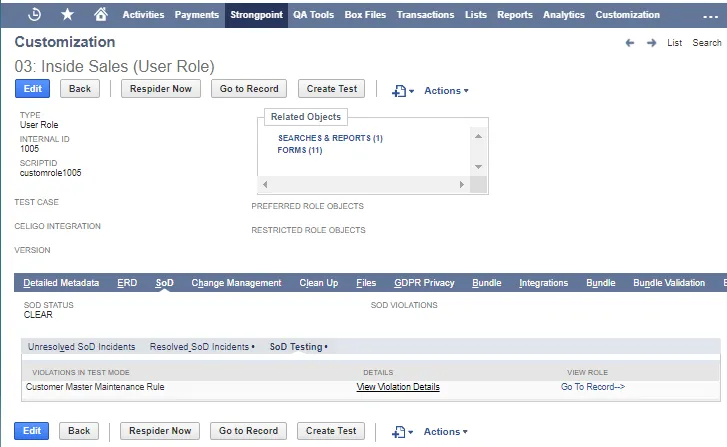SoD Testing Mode
Testing Mode helps you implement a new SoD solution, or to clean up your existing account. By creating and running rules in a test mode, you can identify and resolve potential issues with a rule without creating SoD incidents.
Testing Mode provides two ways to test a rule without generating SoD incidents:
- Test on Roles: checks to see if there are any roles violating the rule.
- Test on Employees: checks to see if any employees are violating the rule.
The violations list in Employee or Role customizations are updated during testing.
To access Testing Mode:
- Create a new Rule or edit an existing Rule: SoD > SoD Rule Library > New or Search
- Open the SoD Rule Processing Status tab.
- Select Test on Roles or Test on Employees.
- Click Run SoD to run the test. It can take over an hour to evaluate large accounts.
Any of these events require a role to be re-evaluated:
Trigger Role Job
- Anytime Role(s) are added/updated
- Anytime the Rules are added/updated
- Manual trigger on the Role
Trigger Role Assignment
- Anytime Role(s) are added/updated
- Anytime the Rules are added/updated
- Anytime Role Assignments on an Employee are added/updated
- Anytime Global Permissions are added/updated
- Also triggered when the Manual trigger on the Role is selected
- Manual Trigger on the Employee
You can manually start the evaluation process, or wait until the Spider runs overnight. To manually run the process:
- Open SoD > SoD Processing Status > Run SoD on User Roles
- Select all of the roles you have modified.
- Click Run SoD
Test Reports
Test Reports are available for both User Role Test Violations and Employee Test Violations:
-
Open SoD > SoD Testing and select one of the Reports:
- User Role Test Violations Summary
- Employee Test Violations Summary
- User Role Test Violation Detailed: displays User Role Name link, SoD Violation, Base Permissions, Conflicting Permissions and User Role link. Report can be exported to Excel.
- Employee Test Violation Detailed: displays a list with Employee Name link, SoD Violation, Non-compliant Roles, Non-compliant Global Permissions, Base Permissions, and Conflicting Permissions. Report can be exported to Excel.
-
Click View for the Rule you want to see.
-
Open the SoD tab.
-
Select SoD Testing and one of the tabs:. There are links to View Violation Details and to open the Role Record.

Details can be exported in an Excel format.